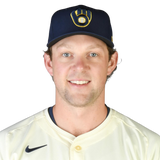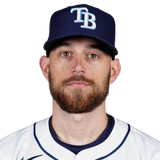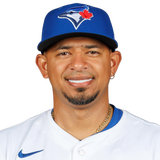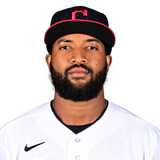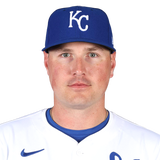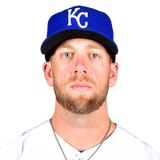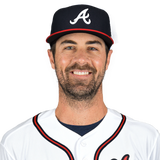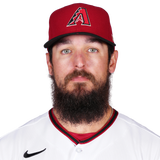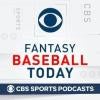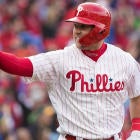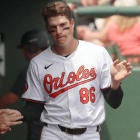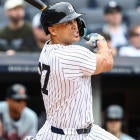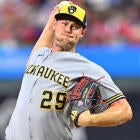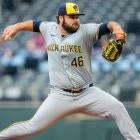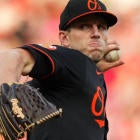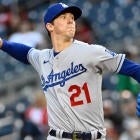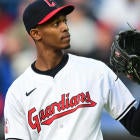I can picture it now. Chris Towers reads the headline for this article and utters to himself, "Full-season statistics are more predictive than partial-season statistics." He then proceeds to virtually rip it up and send it back my way.
Just kidding! Chris would never do that. I think? After our conversation last week regarding Matthew Boyd, I thought of other players we might be forgetting. For whatever reason, as Fantasy Baseball managers, our minds typically drift to the second halves of seasons and remember what we saw last. These big second halves result in inflated ADPs the following season, e.g. Jack Flaherty, Yu Darvish, Max Fried.
It's a good time to remember the forgotten first halves. Perhaps they dealt with injuries later in the season that affected their ability to compete. Maybe their skills just declined. Let's jump in and see what we find.
| ||||||||||
Rhys Hoskins batted .180 in the second half last season. So what? Are we forgetting everything he did in the first half? How about the second half of 2018, too? In the first half of 2019, Hoskins posted a .263/.401/.530 triple slash with 20 home runs and 59 RBI. His .931 OPS and 140 wRC+ both ranked 14th among qualified hitters.
Let's take this one step further. If you combine the second half of 2018 and the first half of 2019, Hoskins batted .252/.375/.537 with 40 home runs and 99 RBI in 156 games. Those are about the numbers you're expecting from Matt Olson except Olson is going 40 picks earlier, on average.
What happened in the second half of 2019 is Hoskins' batted ball data was all over the place. His line drive rate dipped 7% and his fly ball rate ballooned to 52.5%. His pull rate also dropped from 54% in the first half to 39% in the second half. It's worth noting that he was day-to-day with a hand injury in August, something that may have hampered his ability to barrel and pull the ball successfully.
Another note is that in most cases, we are cheering on launch angle. In Hoskins' case, he lifts the ball too much. His 24-degree average launch angle last season was first in all of baseball. A big reason his batting average dipped as much as it did in the second half was because he stopped hitting as many line drives and started hitting more fly balls. If Hoskins gets back to the player he was during that calendar year from second half 2018 to first half 2019, we could be looking at a top-five first baseman, especially in points leagues.
| ||||||||||
Brandon Lowe suffered a leg injury that forced him to miss a large chunk of the second half last season. He only played six games after the All-Star Break. But are people overlooking what he did while he was healthy? Maybe.
In Lowe's 76 first-half games, he batted .276/.339/.523 with 16 home runs, 40 runs scored, 49 RBI and five steals. That's a 162-game pace of 34 home runs, 85 runs, 104 RBI and 10 steals. He posted really strong batted-ball data for a second baseman as well, with a 25.9% line drive rate, 43.1% fly ball rate and 42% hard contact rate.
The biggest question Fantasy managers likely have for Lowe is whether or not he will play every day with the Tampa Bay Rays. He had just 17 at-bats against left-handed pitching in 2019, hitting just .176 with a .653 OPS. In his three previous stops in the minors, however, he hit .326 (46 AB in Triple-A, 2018), .271 (59 AB in Double-A, 2018), and .293 (82 AB in High-A, 2017) against left-handed pitching.
There's a chance Lowe can hit lefties successfully, but wasn't given the opportunity to do so in 2019. You're probably thinking, "Brandon Lowe sounds like the perfect sleeper." He's not perfect. His 34.6% strikeout rate was third highest among all hitters with at least 300 plate appearances last season. Unless he reigns that in, there will be volatility in his batting average. While he hit .270 last season, his expected batting average was just .244. Lowe is more of a middle-infielder than a starting second baseman heading into 2020, but if he cuts down on the strikeouts, his upside is top 10 at the position.
| ||||||||||
Maybe I should have mentioned this earlier but some of these forgotten first halves are warranted. That's the case with Eduardo Escobar. Throughout the first half of 2019, Escobar looked like the steal of Fantasy drafts, and while the home runs remained steady in the second half, the batting average did not. Through the All-Star break, Escobar was batting .296/.353/.543 with 18 home runs and 67 RBI. His line drive rate dropped 4% in the second half while he incrementally hit more groundballs and fly balls. As a result, his batting average dipped to just .236 in the second half.
It wasn't just the batting average. Escobar's slugging dropped to .472 in the second half as well, much closer to the .468 expected slugging percentage he posted for the entire season. While there's no surefire proof, Escobar seems like one of the biggest beneficiaries of the juiced ball from 2019. He posted a 15.2% HR/FB ratio last season despite a 91.1 MPH average exit velocity on fly balls and line drives (31st among 34 qualified third baseman). His 7% barrel percentage from 2019 was also lower than what he posted in 2017 and 2018 when he hit 21 and 23 home runs, respectively. Escobar should still be viewed as a middle or corner infielder who's better suited for H2H points leagues, but don't expect him to hit 30 home runs again.
| ||||||||||
I'm old enough to remember when Domingo Santana was useful in 2019. Santana gained steam as a sleeper late in draft season last year, and for the first half it definitely paid off. Through his first 90 games, Santana batted .286/.354/.496 with 18 home runs, 52 runs scored, 63 RBI and six steals. His 162-game pace, based on those numbers, was 32 home runs, 93 runs, 113 RBI and 10 steals. Santana dealt with an elbow injury last season, which started hampering him in July and plagued him the rest of the season. Take a look below:
Domingo Santana's 2019 | ||
First Half | Second Half | |
OPS | .850 | .468 |
K% | 29.1% | 44.4% |
LD% | 28.4% | 17.4% |
GB% | 39.5% | 58.7% |
FB% | 32.1% | 23.9% |
Hard Contact | 44.9% | 32.6% |
Those differences are egregious! Even with the wretched second half, Santana posted a 12.5% barrel percentage, which was tied for 25th among qualified hitters with Freddie Freeman and Austin Meadows. This is one where Fantasy managers have just completely forgot. Maybe they're right. Maybe Santana is done. But there's zero risk to find out. He's freer than free. He's currently being drafted outside the Top-300. Yes, he strikes out a lot, but the batted ball data still supports a useful player. Draft him on your bench and hope he returns to his first-half form.
| ||||||||||
If Hunter Renfroe kept up what he did in the first half, we'd probably be talking about drafting him in the same range as Franmil Reyes and Kyle Schwarber right now. He didn't keep it up, however.
In the first half, Renfroe was tied for fifth in baseball with 27 home runs and a .921 OPS. He was never going to contribute in batting average, but it really cratered in the second half. In 58 second-half games, Renfroe hit just .161 while striking out 36.6% of the time. His hard contact also dipped from 52.1% in the first half to 37.5% during this span.
With no underlying injury to speak of, we have nothing to blame but performance and a hole in his swing. The one saving grace for Renfroe is that if he can get his strikeout rate back to the 24.7% rate it was in 2018, we could be looking at a .250 batting average with 30-35 home runs. Consider Renfroe the discount Schwarber who's going more than 80 picks later. He absolutely should be going ahead of names like Joc Pederson and Aristedes Aquino.
| ||||||||||
In 68-first half games, Hunter Dozier batted .282/.367/.532 with 13 home runs and 45 RBI. During that time, he posted above average plate discipline and batted ball data, evidenced by his 11.5% walk rate and 48.1% hard contact rate. He did miss three weeks in June last season with a chest injury, but was an above average hitter even once he returned.
While the strikeouts went up and the walks went down in that second half, Dozier still posted an .843 OPS in 71 games. The end result was a career-year for the former first-round pick. So why is nobody talking about him? For one, he plays in Kansas City. Say what you want about the Royals, but if Dozier is batting cleanup, he will have a ton of opportunities in the top half of that lineup.
It just comes down to health. Dozier's dealt with a ton of injuries in the minors and had the aforementioned chest issue in 2019. If he can stay healthy, however, he'll provide similar or better value to Eduardo Escobar who's going about 60 picks earlier.
| ||||||||||
I only have two starting pitchers for you considering all the pitchers broke out in the second half! There are many players who have been helped by the delayed start to the season, and Cole Hamels is one of them. Hamels was shut down this spring with a shoulder injury, but is now expected to be ready when play resumes. Hamels had a stellar first half, posting a 2.98 ERA and a 1.20 WHIP with 97 strikeouts in 99.2 innings pitched. His 12.3% swinging strike rate in the first half ranked 21st among all qualified starting pitchers. And then the injuries happened.
Hamels suffered an oblique strain in late June and then a shoulder in September. The injuries limited Hamels to just 10 starts in the second half where he posted a 5.79 ERA and a 1.83 WHIP. His walks got out of control and he lost a tick of velocity off each of his pitches. His swinging strike rate dipped to just 10.9% compared to the 12.3% earlier in the season. Hamels is currently the 92nd starting pitcher off the board around pick 300. Before the injury in spring, Hamels was a popular late-round target. He should once again move ahead of names like Julio Teheran, Jon Lester, Jose Quintana and Mike Fiers.
| ||||||||||
Caleb Smith is Matthew Boyd lite, going 50 picks later. In his first 11 starts, Smith posted a 3.41 ERA and a 1.02 WHIP. During this span, he flashed elite strikeout upside. His 31.5% strikeout rate ranked fifth in baseball while his 15.1% swinging strike rate ranked fourth. And then, like Hamels, Smith's season was derailed by an injury. Smith landed on the injured list with a hip injury, which derailed him for a full month. Upon returning, the strikeouts remained but the rest of the production did not.
Over Smith's final 16 starts, he posted a ghastly 5.36 ERA and 1.39 WHIP. His fastball dropped a tick while he lowered his changeup usage by almost 8%. As a result, his BB/9 jumped from 2.73 to 4.12 and his swinging strike rate dipped to a much more pedestrian 10.9%.
I happen to believe Smith was affected by that hip injury the rest of the way. It would totally explain the drop in velocity and lack of command. If he can pitch somewhat close to the numbers he posted when healthy in those first 11 starts, you're looking at a top-30 starting pitcher. He represents higher upside than names like Dallas Keuchel and Jose Urquidy, who he's currently being drafted behind.








